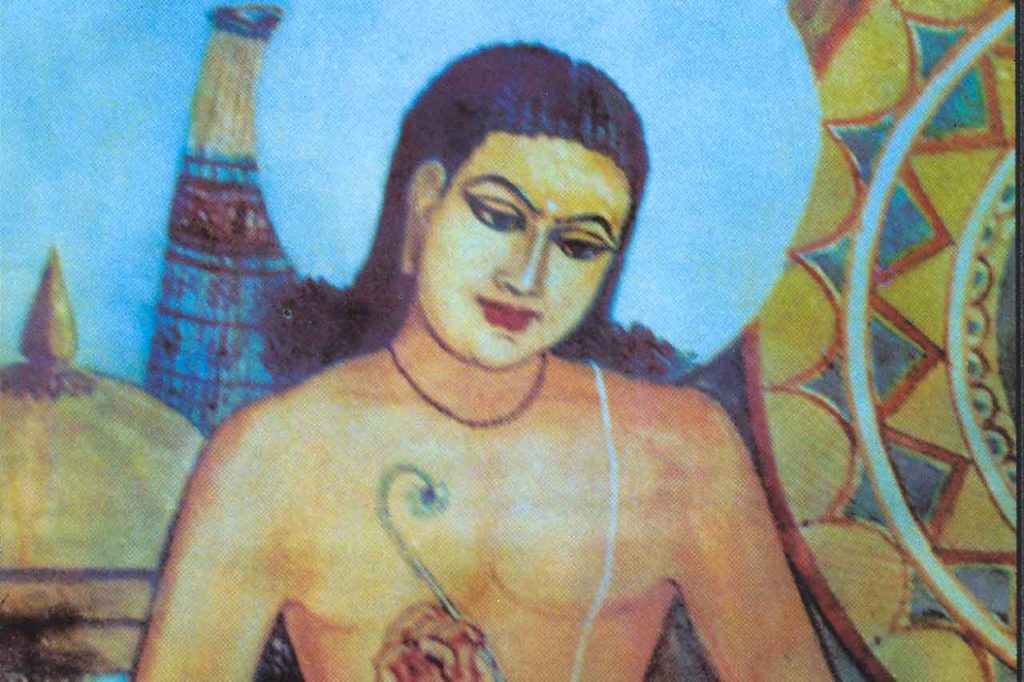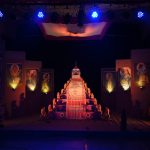Srimanta Sankaradeva founded a distinct and new philosophy, which had some unique characteristics. He founded a new Vaishnavite order within the Sanatana Dharma or Hinduism. The present author has named this philosophy as Vivartanavâda as it facilitates the elevation of the Jiva from the primary dual state to the non-dual state of identity with Brahma. The pertinent features of this philosophy are :
(1) Brahma is the supreme truth. It is shapeless and beyond all attributes.
(2) Brahma and Iswara (God) are the same, even though Iswara is the abode of all attributes.
(3) Brahma or Iswara is there in every being.
(4) Iswara and His creations are not different.
(5) Jiva (creature) is a component of God. The former constitutes the body of the latter.
(6) The creation is temporary, but not unreal.
(7) Mâyâ (illusion) is an attribute of God and its influence can be avoided by the grace of God.
(8) One becomes God as one realises the identity of God and the five elements.
While these features are seen in different branches of Sanâtana Indian philosophy in different degrees, these are not completely available in any of them at the same time. Thus the uniqueness of Vivartanavâda is the composition of ideology in totality. While some of these features are found in different branches of Indian philosophy individually, all the features are not available together at the same time in any of them. There lies the uniqueness of Srimanta Sankaradeva’s philosophy. Moreover his Vivartanavâda differs from the other Indian philosophies in many important aspects. We will dwell upon these departures or differences as the case may be, in the present note.
A major characteristic of Srimanta Sankaradeva’s philosophy is that it preaches equality of the Nirguna Brahma and Saguna Iswara. He says this categorically in a verse of his magnum opus Kirtana-ghoshâ,
Tumi Paramâtmâ jagatara Isha eka
Eko bastu nâhike tomâta byatireka
(Kirtana-ghoshâ / 519)
[Meaning : You are the universal self as well as the one supreme God of the creation. There is nothing other than you.]
Thus the Paramâtmâ or universal self, which is beyond all attributes and Iswara, the supreme God, Who is the abode of all virtues are the same. No other Sanâtana Indian philosophy had taken this position before Srimanta Sankaradeva. That was why the branches of Jnâna Mârga (path of knowledge) and Bhakti Mârga (path of devotion) had always remained wide apart in Sanâtana Hinduism. It was Srimanta Sankaradeva, who brought the two paths together and thus did a great service to Sanâtana Hinduism. He wrote many treatises on devotion beside composing many devotional hymns and thus tried his best to enlighten his disciples about the true path to be followed in life. In fact, he composed thirty books in total. This brings out his stress on knowledge. He declares the importance of spiritual knowledge in a verse of his book Nimi navasiddha sambâda,
Howe jnânasunya / kona pâpa punya / karite napâre sâra
Bishaya byâkula / samyake bâtula / nuguche jâtanâ târa
(Nimi navasiddha sambâda / 56)
[Meaning : One who is devoid of knowledge, cannot differentiate between vice and virtue. He gets totally immersed in mundane affairs like a mad man and his woes never end.]
Srimanta Sankaradeva preached loyalty to a single supreme entity like the monists. This is easily said than done. There have been many monist saints in India, but most of them worshipped additional entities too. For instance, saint Jnanadeva eulogized Rukmini, Shiva and Parvati, though his personal God was lord Krishna only. But Srimanta Sankaradeva strictly adhered to his personal God, lord Krishna. He was a puritan in this respect. He banished any deviant from his order itself. There was no place of any entity other than lord Krishna in Srimanta Sankaradeva’s Eka Sarana Nâma Dharma. No other order stuck to their avowed principle with such sincerity and strictness. Even Adi-Sankaracharya worshipped five deities. So Srimanta Sankaradeva was a truer monists than the theorists of monism. To make it more precise, he practised the essence of monism in real life also.
Srimanta Sankaradeva differed from the great monist saint, Adi-Sankaracharya in his attitude towards creation also. Adi-Sankaracharya declared the Jagat or creation as Mithyâ or false. For him, Brahma alone was true. He said, Brahma Satya Jagat Mithyâ. But Srimanta Sankaradeva treated the Jagat as the play-field of God. And the object, which God relishes in cannot be untrue. Srimanta Sankaradeva said in his transcreation of Bhâgavata,
Tumi Brahma tattva / jagata jateka / tomârese krirâ bhânda
(Bhâgavata / 3 / 157)
[Meaning : You are the supreme entity, Brahma. The entire creation is nothing but your play-field.]
According to Adi-Sankaracharya, even Iswara is Mâyâ or false. He said,
Ekâbupâdhi parajivayostayoh
Samyangnivâse na paro na jivah
(Vivekachurâmani / 244)
Adi-Sankaracharya denied the existence of the Saguna Iswara. He acknowledged the existence of only Nirguna Brahma. He said categorically in his commentary of Brahmasutra,
Samasta bishesharahitang nirbikalpameba
Brahma pratipattabyang na tadbiparitam
(Brahmasutra Bhâsya / 3 / 2 / 11)
But Srimanta Sankaradeva considered Iswara as non-different from Brahma. For him, Iswara is above Mâyâ. He categorically said that Bhagavanta or Iswara was the supreme entity as described in the Vedânta. He said in his transcreation of Bhâgavata,
Jito prakritita para prabhu Bhagavanta
Vedântaro mukhya bhâge jâka prakâshanta
(Bhâgavata / 10 / 469)
[Meaning : God is above the Prakriti or creation. The main content of Vedânta express Him only.]
Since the monists like Adi-Sankaracharya did not think in this line, Iswara was different from Brahma for them. So devotion to any entity including Iswara could not be supported by their monistic theory. But Adi-Sankaracharya did exactly that when he worshipped five deities. That means he did not practise his own monism. His theory was impractical. But Srimanta Sankaradeva’s theory was practicable because he equated Brahma with Iswara.
The monists make attempt to surmount Mâyâ by making auto-suggestions like Ahang Brahmâsmi (I am Brahma), Tattvamasi (Thou art that) etc. One’s purpose here is to identify oneself with Brahma. But Srimanta Sankaradeva advised the devotees to worship God in order to get His blessings so that God’s Mâyâ could be surmounted. He said this in a verse of his Kirtana-ghoshâ,
Harinâm hiye dhari / Harinâm sadâ smari / Tebese Harira Mâyâ tari
(Kirtana-ghoshâ / 599)
[Meaning : We can surmount Mâyâ only by holding the name of lord Hari in our heart and chanting His name always.]
So it is clear that Srimanta Sankaradeva considered Jiva as incapable of surmounting God’s Mâyâ. It could be possible only by the grace of God, he opined. But the monists think that Jiva can surmount Mâyâ on his own. This is a basic difference between these two lines of thinking. Therefore Srimanta Sankaradeva’s philosophy cannot be clubbed together with monism.
Adi-Sankaracharya held the human body in contempt. He said,
Mâtâpitrormalodbhutang
Malamângsamayang bapuh
(Vivekachurâmani / 287)
But Srimanta Sankaradeva considered the human body as a holy tool for worshipping God. Such a precious body could be had only after numerous births, he said. (Bhakti Ratnâkara) Such attitudinal difference arose due to the difference in attitude towards the creation, which was treated as a play-field of God by Srimanta Sankaradeva and as a false entity by Adi-Sankaracharya. Srimanta Sankaradeva did not share the negative Neti Neti Neti approach of the monists towards the creation. He sought to explain every thing positively. Here he departed from the Upanishadic tradition. The positive attitude of Srimanta Sankaradeva helped him in his reformist social movement. He did not renounce the world, but worked for the upliftment of the world.
Srimanta Sankaradeva’s philosophy had elements of both Parinâmavâda and Vivartavâda. He considered Jiva as a changed form of Iswara. (Bhakti Ratnâkara) This is an element of Parinâmavâda. In other words, it is a departure from monism. But at the same time Srimanta Sankaradeva also alluded to the illusion of snake in rope, while refering to the creation. This is an element of Vivartavâda. So his philosophy Vivartanavâda cannot be categorized exclusively as either Parinâmavâda or Vivartavâda. He blended Parinâmavâda and Vivartavâda in his Vivartanavâda. The way he blended these two elements is a unique thing. Such a blending is not seen in other philosophers.
The way Srimanta Sankaradeva termed Iswara as different from Jiva is a clear proof that he was not a pure monist. He termed Iswara as Uttama Purusha (Best man) and Jiva as Adhama Purusha (Worst man). (Bhâgavata 11 / 78) This is a clear evidence that the saint considered Iswara and Jiva as different entities. But this difference disappears at the time of dissolution of the creation, according to Srimanta Sankaradeva. He says that at that point, the Jiva merges in Iswara. (Anâdi Pâtana / 50) This approach is different from that of Maddhacharya, for whom the difference between Iswara and Jiva persists.
Another feature of Srimanta Sankaradeva’s blending Parinâmavâda and Vivartavâda is that while he termed Iswara and devotee as different, he also accepted the identity of both in the final analysis. Such a feature is seen in Dvaitâdvaitavâda of Nimbarka also. But Nimbarka was a strict believer of Parinâmavâda, which refutes his theory of identity between Iswara and devotee. Moreover he worshipped dual entities, which is different from tenets of Eka Sarana Nâma Dharma preached by Srimanta Sankaradeva. Achintya Bhedâbhedavâda, the philosophy of Chaitanyadeva is almost akin to Nimbarka’s. Moreover Achintya Bhedâbhedavâda failed to explain the identity and duality of Iswara and Jiva at the same time; they just declared it to be beyond all interpretation. Against that, Srimanta Sankaradeva explained that paradox very successfully and minutely. So Srimanta Sankaradeva’s philosophy cannot be clubbed with any of them.
Srimanta Sankaradeva’s philosophy also differed from that of Ramanuja, the proponent of qualified monism. Ramanuja considered Brahma as summation of all sentient and insentient beings. (Sri Bhâshya 2 / 2 / 33) But Srimanta Sankaradeva talked about a different relationship between Jiva and Iswara. He treated Jiva as equivalent to Iswara, since Iswara permeates all beings. The saint enjoined upon every one to treat all beings as manifestations of lord Vishnu. (Kirtana-ghoshâ / 1820) Ramanuja could not share this perspective of Srimanta Sankaradeva. Ramanuja analysed the sentient and insentient beings differently. He did not accept their identity or equality. Another difference of Srimanta Sankaradeva’s philosophy from that of Ramanuja lies in their distinct perspectives about Brahma. While Srimanta Sankaradeva termed Brahma as shapeless and beyond all attributes, Ramanuja termed Brahma as only attributeful and equipped with a body. For him, the universe constitutes the body of Brahma. (Sri Bhâshya 1 / 1 / 1, 1 / 4 / 27)
It is true, both Srimanta Sankaradeva and Ramanuja accepted the existence of Brahma inside every creature. But there is a subtle difference between them regarding their conception of the end of the creatures. Srimanta Sankaradeva believed in the ultimate merger of all entities in Brahma at the end of Kalpa (the cycle of existence). But according to Ramanuja, the creatures remain appended to and united with Brahma in a subtle form at the end of Kalpa; they do not merge in Brahma. Here Srimanta Sankaradeva is more nearer to monism, which accepts Brahma as the ultimate reality.
Nevertheless, Srimanta Sankaradeva did not consider it important for the devotees to strive for merger with Brahma; instead his ideology stresses on inculcating devotion to Iswara. In that respect, he is similar to Ramanuja or for that matter any other devotional philosopher. The more prominent difference of Srimanta Sankaradeva’s philosophy with that of Ramanuja lies in the fact that Ramanuja abided by Parinâmavâda predominantly. Contrary to that, Srimanta Sankaradeva’s philosophy Vivartanavâda had elements of both Parinâmavâda and Vivartavâda, as explained above. The same consideration differentiates it from the Shuddhâdvaitavâda of Vallabhacharya, who also abided by Parinâmavâda.
In fact Srimanta Sankaradeva’s philosophy is not similar to any devotional philosophy, because none of these other devotional philosophies preached the tenet of Eka Sarana like him. Eka Sarana means submission to a single ultimate supreme entity, which happens to be lord Krishna in Srimanta Sankaradeva’s case. He strictly forbade worship of any other entity. But we see that other devotional cults have worship of a female entity along with a supreme entity. Thus Radha, Rukmini, Sita, Lakshmi etc are worshipped in these orders along with Krishna, Vitthala, Rama, Narayana etc. Even the Alwars worshipped the female deities Lakshmi, Sri and Bhu.
We have shown that Srimanta Sankaradeva’s philosophy differs from all other branches of Sanâtana Hindu philosophy like monism, qualified monism, dualism etc. But his philosophy contains elements of some of these in such a fine blend that they constitute a new and unique branch of philosophy itself. Moreover it is not that he borrowed these elements from some already founded philosophy. Most of these were his own thinking. This becomes evident from the fact that saints like Vallabhacharya and Chaitanyadeva were born much later than Srimanta Sankaradeva. So the ideological component of Srimanta Sankaradeva’s Vivartanavâda were devised by himself.
Srimanta Sankaradeva’s is an integral philosophy as it contains elements from different perspectives. It became posssible only because he had an integral view of life. He even went beyond monotheism when he equated Brahma and Iswara. It is significant that he paid obeisance to the eternal entity in the form of Brahma at the very outset of his book Kirtana-ghoshâ. His philosophy could facilitate a journey from the gross to the subtle for the devotee as it covers ideas ranging from dualism to monism. It is the first ever practical philosophy of the world which is fully in tune with the religious system of the order. We have named this philosophy as Vivartanavâda considering the stress on spiritual evolution of the devotee in this branch. Evolution is an important theme in Srimanta Sankaradeva’s writings. In fact he started his Kirtana-ghoshâ with descriptions of the incarnations of Iswara.
Earlier published in www.sankaradeva.com




